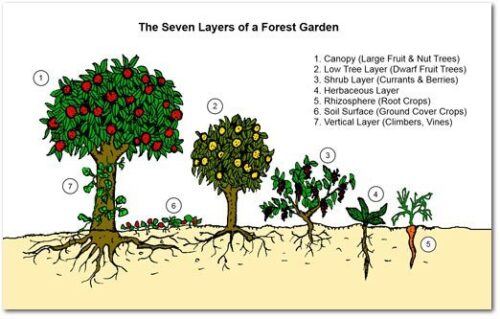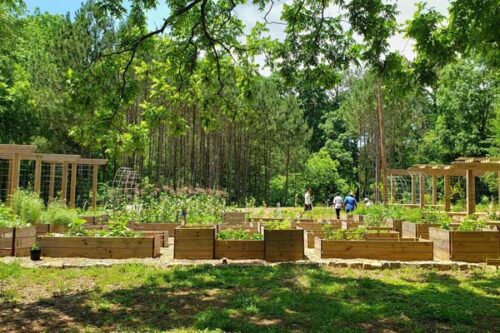Food Forests
Here is a basic page layout with no sidebarAccording to Project Food Forest, a food forest (also called a forest garden) is “a diverse planting of edible plants that attempts to mimic the ecosystems and patterns found in nature. Food forests are three dimensional designs, with life extending in all directions – up, down, and out.”
There are seven layers (or eight if you consider the mycelial, or mushroom, layer) of a food forest – the overstory, the understory, the shrub layer, the herbaceous layer, the root layer, the ground cover layer, and the vine layer. Using all the layers allows more plants to grow in an area without any competition for resources like water and sun.
The seven layers
- Canopy – large fruit and nut trees
- Low Tree Layer – smaller fruit trees
- Shrubs – currants and berries
- Herbaceous – herbs
- Rhizosphere (Root) – root vegetables
- Soil surface – ground cover
- Vertical (or Vine) layer – vines and climbers
Because of the way food forests are designed, planted and grown using permaculture methods, they need little to no human management such as weeding or fertilizing. Forests are rich in biodiversity and highly fertile, meaning they’re ideal for growing many different kinds of food.
It is important to note for any food forest enthusiasts that it does take a few years for the forest to be completely functioning – fruits generally do not grow right away and need several years. While you’re waiting, you can plant other vegetables that you’d generally find in a backyard garden. And speaking of backyard gardens, there currently is a movement toward backyard food forests so that’s an option also. Just make sure to share any food you grow that you won’t be able to eat with your community!
Food forests address food insecurity and food deserts, especially in urban environments, because communities grow and share their own food for free. Food forests also foster community, resilience and empowerment. They encourage participation and knowledge sharing in exchange for food. They’re also an oasis of nature for urban dwellers.
Create Your Own Food Forest
Want to create a food forest in your area but don’t know what to do? Check out the following for tips and more information.
- Permaculture Apprentice – A step-by-step guide to creating a food forest by someone who actually did just that.
- Permaculture Woman also shares a guide to starting a food forest.
Food Forest Examples
Food forests and gardens are being planted all around the globe – below are only a few examples.
Beacon Food Forest – This seven acre food forest is one of the biggest and best of its kind, located in Seattle, Washington. It combines permaculture, urban farming and woodland attributes to create edible forest ecosystems. The forest includes fruit trees, a berry patch, a nut grove, a children’s educational areas, and shaded walking paths.
Swale is an 80ft by 30ft floating food forest located on a barge that travels in waters around New York City. It’s an innovative project meant to inspire city-dwellers to rethink the relationship between our cities and our food. This urban garden serves as both a living art exhibit and an educational farm and hopes to shift the concept of fresh and healthy foods from an “expensive commodity” to a public service.
Bronx River Foodway – And on land in NYC is the Bronx River Alliance pilot food project, the Bronx River Foodway. The Alliance is demonstrating how a sustainable food landscape can be integrated into a public park and highlights the intersection of food, culture, traditions, history, education, and community. The regenerative design features fruits, nuts, perennial vegetables, medicinals and a pollinator habitat.
Urban Food Forest at Browns Mill – This city park in a designated food desert area is Georgia’s first food forest. At 7.1 acres, it’s one of the largest food forests in the U.S. with 2,200 new fruit and nut trees. Along with the customary fruits and nuts, it also produces specialty items like herbs, mushrooms and vegetables. It is managed by neighborhood residents and food is shared first with volunteers.
Dr. George Washington Carver Edible Park – This is one of the oldest food forests on the East Coast, located in downtown Asheville, North Carolina. The 20+ year old orchard boasts figs, apples, pears, chestnuts, hazelnuts, plums, peaches, grapes and paw paw – among other food. As with many food forests, this edible park also features an annual vegetable garden, a butterfly garden, and a walking path that winds through the orchard.
Lorem Ipsum Dolor
Nunc et vestibulum velit. Suspendisse euismod eros vel urna bibendum gravida. Phasellus et metus nec dui ornare molestie. In consequat urna sed tincidunt euismod. Praesent non pharetra arcu, at tincidunt sapien. Nullam lobortis ultricies bibendum. Duis elit leo, porta vel nisl in, ullamcorper scelerisque velit. Fusce volutpat purus dolor, vel pulvinar dui porttitor sed. Phasellus ac odio eu quam varius elementum sit amet euismod justo.
Lorem Ipsum Dolor
Nunc et vestibulum velit. Suspendisse euismod eros vel urna bibendum gravida. Phasellus et metus nec dui ornare molestie. In consequat urna sed tincidunt euismod. Praesent non pharetra arcu, at tincidunt sapien. Nullam lobortis ultricies bibendum. Duis elit leo, porta vel nisl in, ullamcorper scelerisque velit. Fusce volutpat purus dolor, vel pulvinar dui porttitor sed. Phasellus ac odio eu quam varius elementum sit amet euismod justo.
Lorem Ipsum Dolor
Nunc et vestibulum velit. Suspendisse euismod eros vel urna bibendum gravida. Phasellus et metus nec dui ornare molestie. In consequat urna sed tincidunt euismod. Praesent non pharetra arcu, at tincidunt sapien. Nullam lobortis ultricies bibendum. Duis elit leo, porta vel nisl in, ullamcorper scelerisque velit. Fusce volutpat purus dolor, vel pulvinar dui porttitor sed. Phasellus ac odio eu quam varius elementum sit amet euismod justo.
Lorem Ipsum Dolor
Nunc et vestibulum velit. Suspendisse euismod eros vel urna bibendum gravida. Phasellus et metus nec dui ornare molestie. In consequat urna sed tincidunt euismod. Praesent non pharetra arcu, at tincidunt sapien. Nullam lobortis ultricies bibendum. Duis elit leo, porta vel nisl in, ullamcorper scelerisque velit. Fusce volutpat purus dolor, vel pulvinar dui porttitor sed. Phasellus ac odio eu quam varius elementum sit amet euismod justo.
Lorem Ipsum Dolor
Nunc et vestibulum velit. Suspendisse euismod eros vel urna bibendum gravida. Phasellus et metus nec dui ornare molestie. In consequat urna sed tincidunt euismod. Praesent non pharetra arcu, at tincidunt sapien. Nullam lobortis ultricies bibendum. Duis elit leo, porta vel nisl in, ullamcorper scelerisque velit. Fusce volutpat purus dolor, vel pulvinar dui porttitor sed. Phasellus ac odio eu quam varius elementum sit amet euismod justo.


